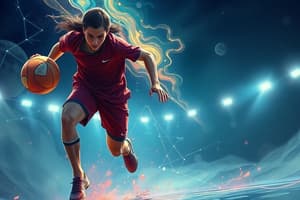Podcast
Questions and Answers
Interference in the acquisition of a skill can occur when two tasks are
practiced in sequence with an interim period of?
Interference in the acquisition of a skill can occur when two tasks are practiced in sequence with an interim period of?
- less than 24hrs
- less than 8hrs
- less than 6hrs (correct)
- less than 12hrs
what is the effect of aging on muscle?
what is the effect of aging on muscle?
- increased range of motion
- increased elasticity
- increased stiffness (correct)
- decreased hysteresis
The strain loads for a ligament during most daily activities, including walking
and jogging, is?
The strain loads for a ligament during most daily activities, including walking and jogging, is?
- in the toe region up to 1% strain (correct)
- in the linear region up to 3% strain
- in the linear region up to 5% strain
- in the plastic region up to 8% strain
which mechanism can lead to ACL rupture?
which mechanism can lead to ACL rupture?
which activity is likely to exacerbate patellofemoral pain?
which activity is likely to exacerbate patellofemoral pain?
which posture is most free of mechanical stress?
which posture is most free of mechanical stress?
What variable factor is in the NIOSH recommended weight limit (RWL)
formula?
What variable factor is in the NIOSH recommended weight limit (RWL) formula?
An event in the stance phase of human gait where there is no horizontal force
An event in the stance phase of human gait where there is no horizontal force
This source of power generation during gait increases most prominently with
speed (i.e., between walking, running, and sprinting)
This source of power generation during gait increases most prominently with speed (i.e., between walking, running, and sprinting)
A gait pathology caused by gluteus medius weakness
A gait pathology caused by gluteus medius weakness
The effects of stroke on gait fits into which Perry (2010) functional category?
The effects of stroke on gait fits into which Perry (2010) functional category?
motor learning is defined as the:
motor learning is defined as the:
the moment arm is effected by:
the moment arm is effected by:
which factor does NOT influence force production?
which factor does NOT influence force production?
which factors do NOT confound the angle torque relationship
which factors do NOT confound the angle torque relationship
what is a reason for the force velocity relationship?
what is a reason for the force velocity relationship?
bi articular muscles play a key role in:
bi articular muscles play a key role in:
which movement would you expect to place the highest load on the ACL?
which movement would you expect to place the highest load on the ACL?
What factors/data are required to develop a model to measure patellofemoral joint (PFJ) stress?
What factors/data are required to develop a model to measure patellofemoral joint (PFJ) stress?
free body diagrams:
free body diagrams:
weight is:
weight is:
Which one of these activities would you NOT need to include ground reaction force in a free body diagram?
Which one of these activities would you NOT need to include ground reaction force in a free body diagram?
centre of pressure is
centre of pressure is
the joint reaction force is NOT:
the joint reaction force is NOT:
overexertion can be caused by
overexertion can be caused by
which one the these sub phases is NOT in the gait cycle
which one the these sub phases is NOT in the gait cycle
at initial contact the hip, knee, ankle and foot are mostly in which position?
at initial contact the hip, knee, ankle and foot are mostly in which position?
when we transition from walking to running, we do not see:
when we transition from walking to running, we do not see:
An external torque/moment is NOT produced by:
An external torque/moment is NOT produced by:
Most power generation and absorption occur in which plane(s) of motion?
Most power generation and absorption occur in which plane(s) of motion?
hip abduction occurs in which plane of motion, and at initial contact we ___ power?
hip abduction occurs in which plane of motion, and at initial contact we ___ power?
at toe off, which muscle isn't active
at toe off, which muscle isn't active
factors NOT affecting locomotion as we age include:
factors NOT affecting locomotion as we age include:
a common change in gait as we as is:
a common change in gait as we as is:
the second functional category that gait abnormalities fall into as stated by Perry was:
the second functional category that gait abnormalities fall into as stated by Perry was:
which is not a common pointer for observational gait assessment?
which is not a common pointer for observational gait assessment?
according to the ACSM, a heel to toe drop should be
according to the ACSM, a heel to toe drop should be
developmental biomechanics is multidisciplinary and made up of 4 categories, these include
developmental biomechanics is multidisciplinary and made up of 4 categories, these include
the centre of mass of a limb in a child compared to an adult is
the centre of mass of a limb in a child compared to an adult is
which mechanical method is used to assess the safety of ground surfaces in children's playgrounds?
which mechanical method is used to assess the safety of ground surfaces in children's playgrounds?
Flashcards are hidden until you start studying
Study Notes
Motor Learning and Gait
- Interference in acquiring a skill can occur when two tasks are practiced in sequence with an interim period.
Gait and Aging
- The effect of aging on muscle is significant.
- Factors not affecting locomotion as we age include:
- A common change in gait as we age is:
- The second functional category that gait abnormalities fall into as stated by Perry is:
Patellofemoral Joint (PFJ) Stress
- Factors/data required to develop a model to measure PFJ stress include:
- Activities that are likely to exacerbate patellofemoral pain include:
Ligament Loads and ACL Rupture
- The strain loads for a ligament during most daily activities, including walking and jogging, is:
- Mechanisms that can lead to ACL rupture include:
- Movement that would place the highest load on the ACL is:
Muscle Function and Gait
- A gait pathology caused by gluteus medius weakness is:
- Bi-articular muscles play a key role in:
- At toe off, the muscle that isn't active is:
- Hip abduction occurs in the frontal plane of motion, and at initial contact, we generate power.
Gait Cycle and Joint Forces
- At initial contact, the hip, knee, ankle, and foot are mostly in a:
- During the stance phase of human gait, there is an event where there is no horizontal force:
- Centre of pressure is:
- Joint reaction force is NOT:
- Free body diagrams:
Power Generation and Force Production
- A source of power generation during gait increases most prominently with speed (i.e., between walking, running, and sprinting).
- The moment arm is affected by:
- A reason for the force-velocity relationship is:
- A factor that does NOT influence force production is:
- Overexertion can be caused by:
Studying That Suits You
Use AI to generate personalized quizzes and flashcards to suit your learning preferences.



